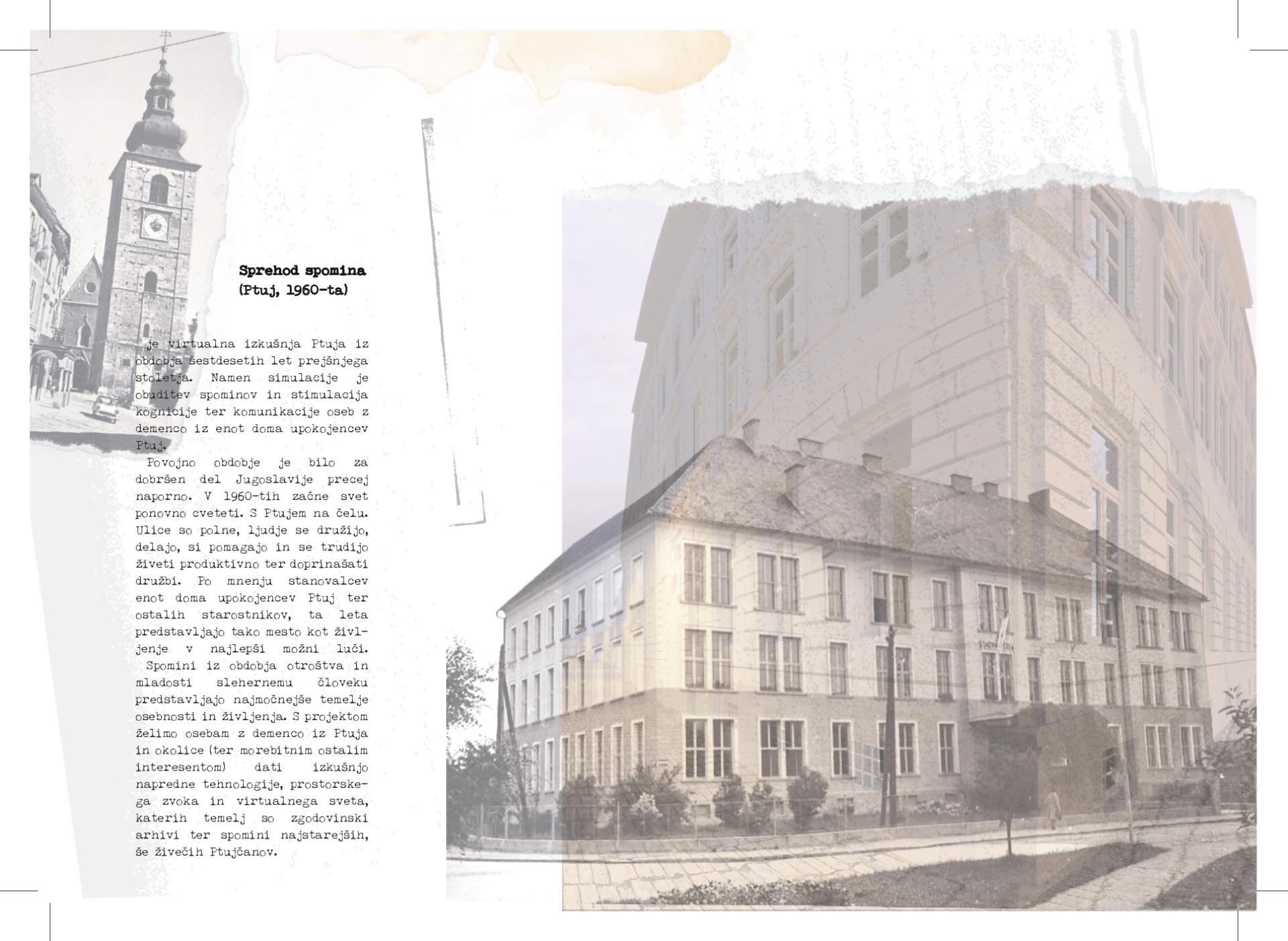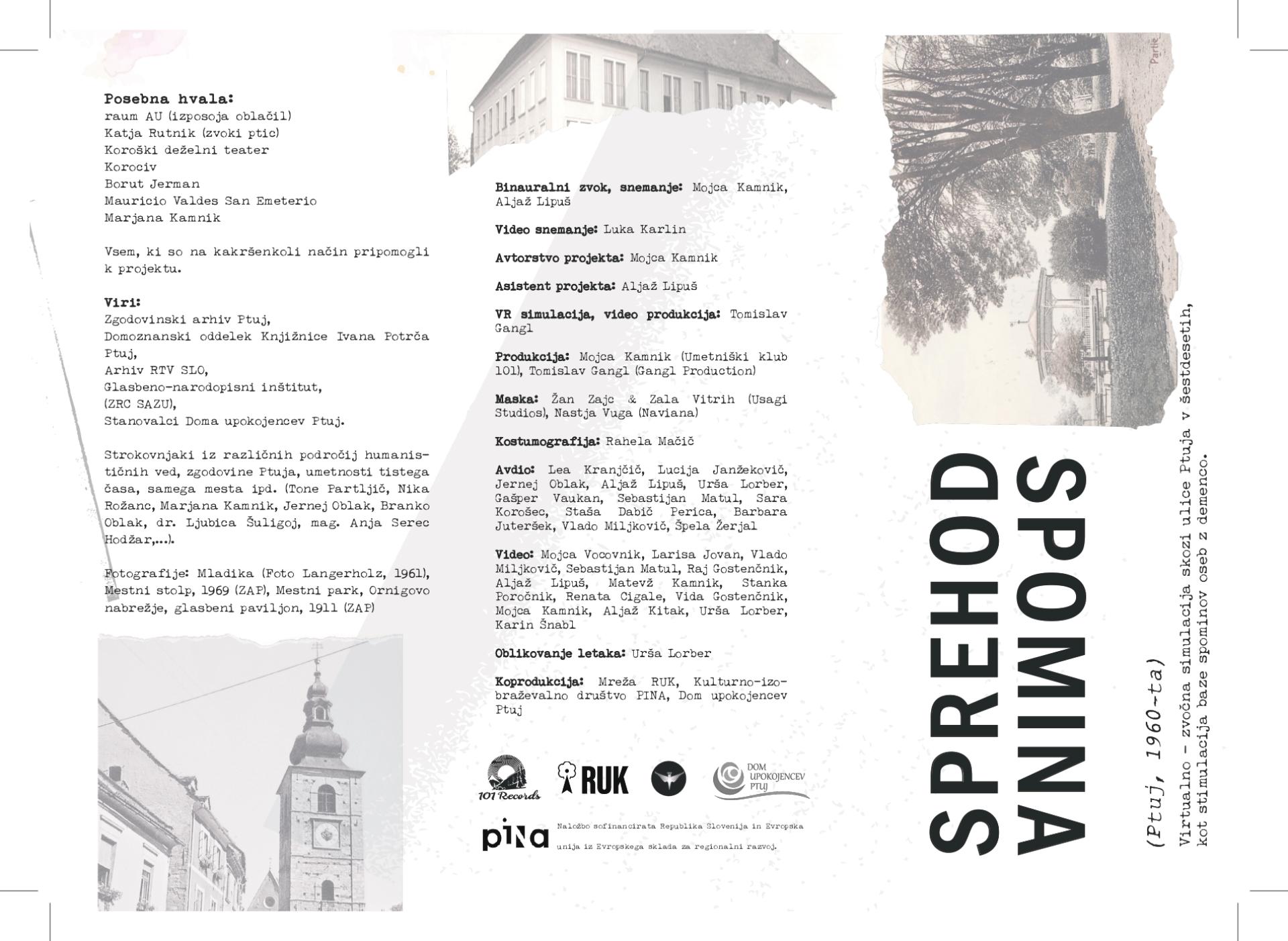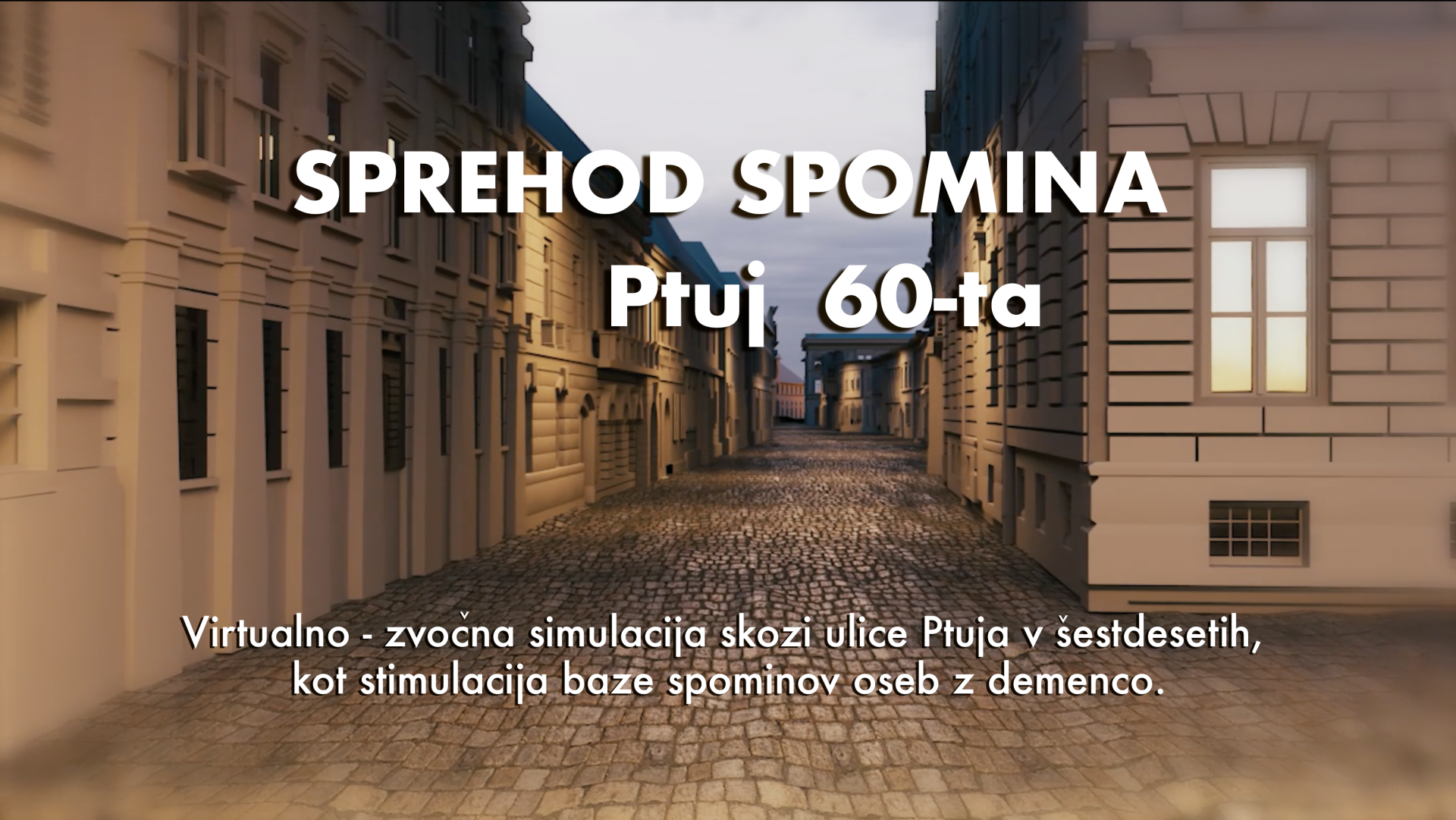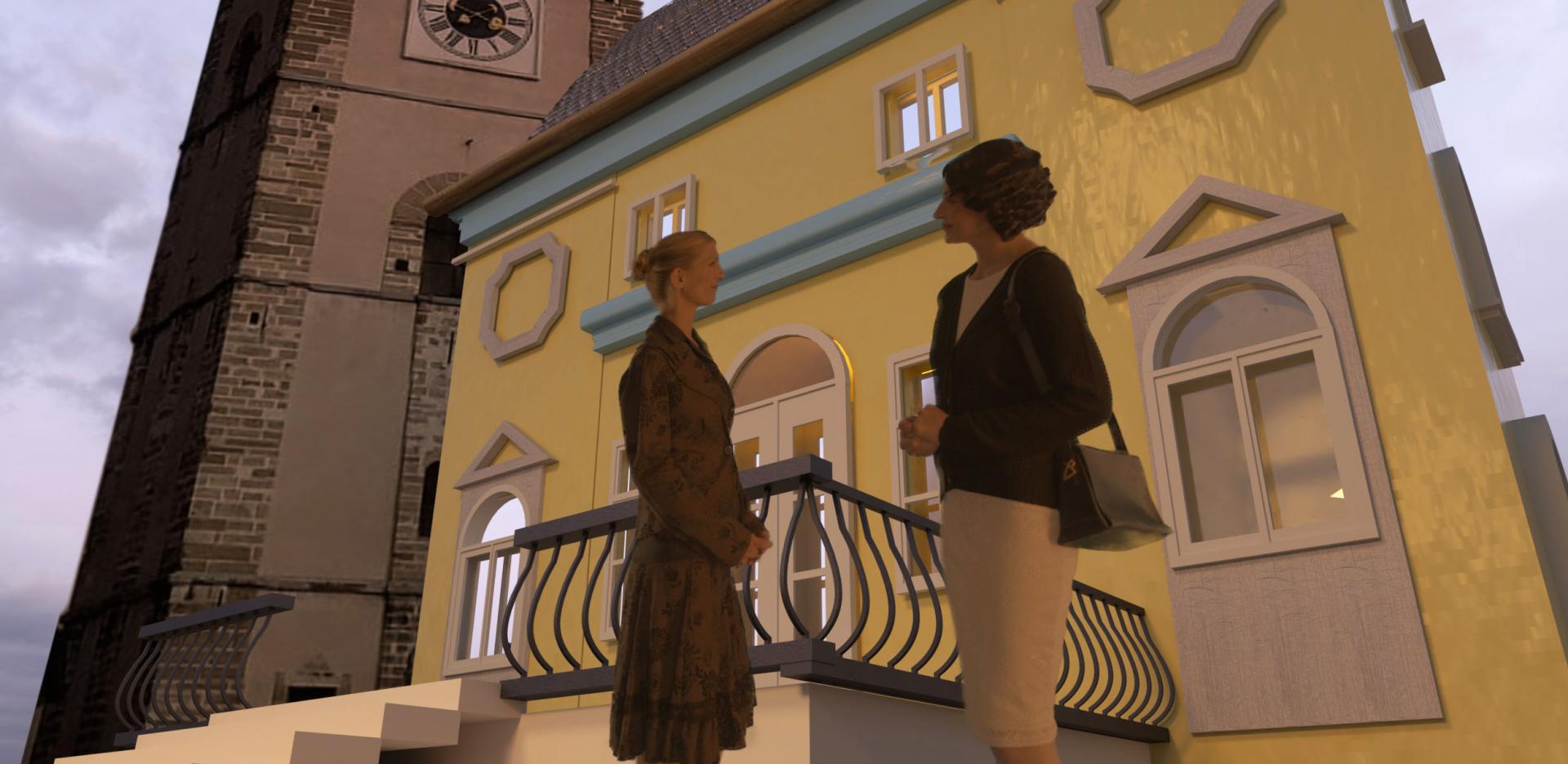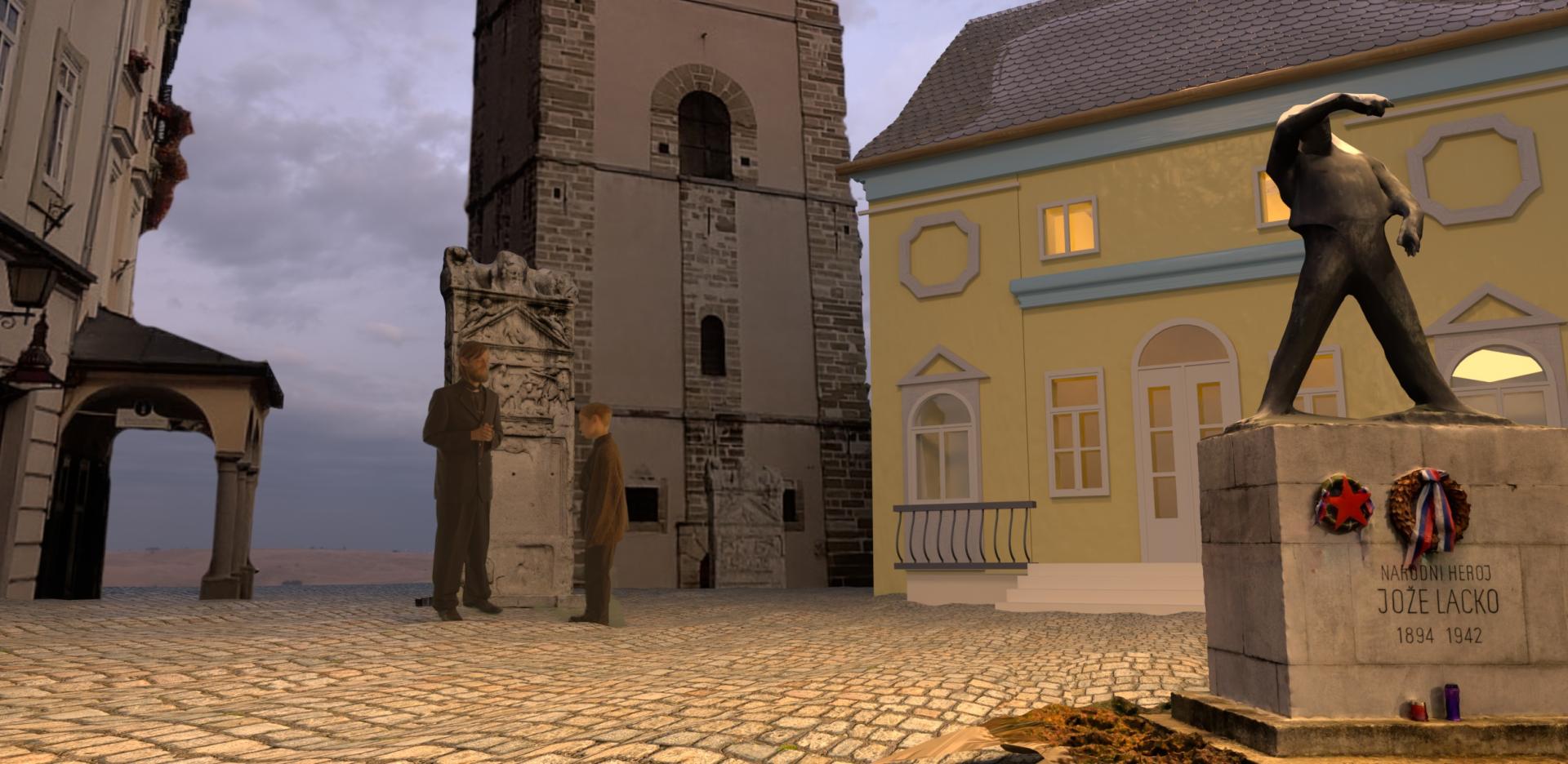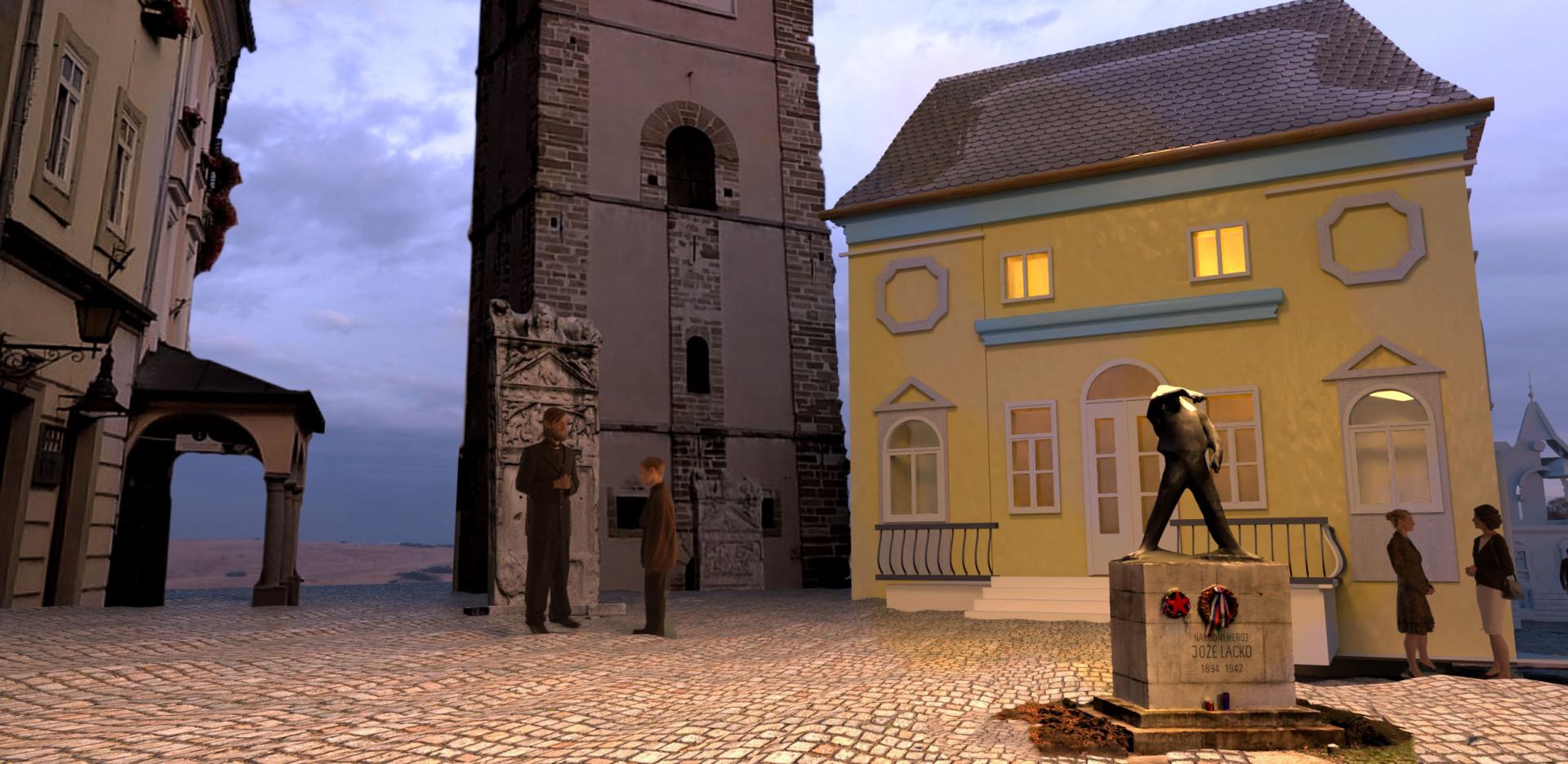Sprehod spomina / Walk of memory
Basic information
Project Title
Sprehod spomina / Walk of memory
Full project title
Sprehod spomina, Ptuj 60-ta / Walk of memory, Ptuj 60s
Category
Prioritising the places and people that need it the most
Project Description
Walk of memory is a virtual simulation of a walk through the most populated streets of Ptuj from the 1960s. The walk includes the urban planning features of the period, as well as the appearance and rituals of the people on the street with a binaural sound. The aim of the project is to bring people with dementia from Ptuj closer to the time of their youth in terms of relaxation and cognitive stimulation.
It represents one of the possibilities of working with people with dementia in the future.
It represents one of the possibilities of working with people with dementia in the future.
Geographical Scope
Local
Project Region
In includes four units of elderly residence in Ptuj (Ptuj, Juršinci, Muretinci, Kidričevo)., Slovenia
Urban or rural issues
It addresses urban-rural linkages
Physical or other transformations
It refers to other types of transformations (soft investment)
EU Programme or fund
Yes
Which funds
ERDF : European Regional Development Fund
Description of the project
Summary
Walk of a memory is a virtual simulation with binaural sounnd of a walk through the most populated streets of Ptuj from the 1960s. The walk includes both a visual perspective, covering both the architecture and urban planning features of the period, as well as the appearance and rituals of the people on the street; it also includes a sound perspective. The latter is built up by the supposed soundscape of the time from the the street dialogues, popular and folk songs of the time to the compositions of the singing of the people living at the time birds along the river Drava.
The original aim of the project is to bring people with dementia from Ptuj and its surroundings (back) closer to the time of the their youth. In this way, we would like to offer them a form of relaxation and stimulation, thus ideally reducing the use of medication and the burden on staff, the person with dementia, and to be able to the memories in immersive way that are, due to the nature of the disease, are their own daily constant.
The project is a form of re-creation of a specific period, or a fictional replica of a time that is most
alive in the memories of the current third generation and today manifested in various forms of retreat. "Time travel" is possible for a few minutes.
The project brings together many fields from cultural heritage, social and psychological work,
ethnology, medicine to 3D modelling and immersive sound, and presents a thread of the past with future and represents one of the possibilities of working with dementia in the future.
It addresses the needs of the older generation with dementia (especially advanced dementia) who, due to critical cognitive decline and physical disability, can no longer function outside their intimate social circle or institutional care. It gives them the opportunity to be part of contemporary cultural and artistic approaches that adapt to their reality.
The original aim of the project is to bring people with dementia from Ptuj and its surroundings (back) closer to the time of the their youth. In this way, we would like to offer them a form of relaxation and stimulation, thus ideally reducing the use of medication and the burden on staff, the person with dementia, and to be able to the memories in immersive way that are, due to the nature of the disease, are their own daily constant.
The project is a form of re-creation of a specific period, or a fictional replica of a time that is most
alive in the memories of the current third generation and today manifested in various forms of retreat. "Time travel" is possible for a few minutes.
The project brings together many fields from cultural heritage, social and psychological work,
ethnology, medicine to 3D modelling and immersive sound, and presents a thread of the past with future and represents one of the possibilities of working with dementia in the future.
It addresses the needs of the older generation with dementia (especially advanced dementia) who, due to critical cognitive decline and physical disability, can no longer function outside their intimate social circle or institutional care. It gives them the opportunity to be part of contemporary cultural and artistic approaches that adapt to their reality.
Key objectives for sustainability
The project addresses sustainability in the sense of preserving and digitising the cultural heritage of their environment; biodiversity in the sense of including bird species that were present along the Drava River before the interventions of the late 20th century; and care for the people who are most in need of our help, our time and our abundance. It represents a way of easing the dying and offers them the chance to feel (visually and aurally) a world that is difficult for them to experience physically due to their illness.
Key objectives for aesthetics and quality
The visual component of the project presents the city of Ptuj in the 1960s. Due to the digital aesthetics, the virtual reality appears as a "washed" reality. Colours and textures are strictly chosen to positively influence the users' perception. Architecture and urban design are reminiscent of the 1960s, but with a softer feel. The sound is built up by supposed dialogues in the street (made up of newspapers, history books and stories of the elderly), sounds of nature (animals, trees), traffic and work. Folk and at the time popular songs performed in the streets add the icing on the cake.
The whole project draws mainly on the accessible public and intimate heritage of the city, in order to be as close as possible to an average day on the street in the youth of the elderly. Due to the nature of dementia, this is the time that should remain alive in their perception for the longest time.
The virtuality and binaural sound make the project immersive. The remaining memories can thus be experienced by the elderly with more senses.
The personalisation of the experience of a specific time and place through the use of advanced technologies offers enormous possibilities to activate elderly people with dementia when this becomes more difficult. In this sense, our project combines the skills of social work, medicine and other staff in institutional care, sound and visual arts, and cultural heritage.
The whole project draws mainly on the accessible public and intimate heritage of the city, in order to be as close as possible to an average day on the street in the youth of the elderly. Due to the nature of dementia, this is the time that should remain alive in their perception for the longest time.
The virtuality and binaural sound make the project immersive. The remaining memories can thus be experienced by the elderly with more senses.
The personalisation of the experience of a specific time and place through the use of advanced technologies offers enormous possibilities to activate elderly people with dementia when this becomes more difficult. In this sense, our project combines the skills of social work, medicine and other staff in institutional care, sound and visual arts, and cultural heritage.
Key objectives for inclusion
Institutional care is understaffed, often resulting in a lack of attention to those who need it most. Attention in terms of longer conversations, creative and productive time, stimulation of communication, motor skills and so on. The "Memory Walk" only requires a pair of VR glasses, a pair of headphones and a few minutes of the employee or a relative's time. The necessary relevance of personalisation makes the project most useful in the Ptuj area and for those who have been connected to Ptuj in any way. Also, due to the small size of the country, the project can be applied in many settings, as the city is known to all (oldest city in Slovenia, kurents). Similar projects could also be applied more widely, but the applicability depends on the knowledge of the individual programme by the employees dealing with people with dementia.
The project is primarily aimed at more advanced stages of dementia, but is also well responded to in earlier stages. The project is set in a historical local context and involves all social, cultural, religious and national classes present at the time.
The project is primarily aimed at more advanced stages of dementia, but is also well responded to in earlier stages. The project is set in a historical local context and involves all social, cultural, religious and national classes present at the time.
Results in relation to category
The "Memory Walk" project, employing Virtual Reality (VR) technology, has yielded significant outcomes and impacts in dementia care. Surprisingly, residents universally embraced the VR experience, exhibiting positive emotional and physical responses, including memory triggering and calmer behavior. This resulted in an improved sense of well-being, enhanced communication, and insights for caregivers. The project's impact extends beyond direct beneficiaries, benefiting caregivers and contributing to the evolving landscape of dementia care. The success underscores the potential of VR as a therapeutic tool, offering a more meaningful and enjoyable daily life for elderly residents, thus influencing broader industry practices.
How Citizens benefit
The people for whom the project is intended participated in the very beginning by telling stories of their lives, which was our starting point. Passers-by on the streets exploring the area, staff in libraries, museums, galleries and pubs have also contributed a great deal to the content with talks and advice.
In the second phase of the project, voice actors were invited to participate, adding the icing on the cake with their authentic accents; visual actors contributing their archaic and endearing characters also contributed ideas for costume design (following the folk principle - every grandmother or aunt has something in her closet to use).
We believe that in this kind of project, it is essential to work with the local community, both immediate and wider, as this is the only way to create a nostalgic 'time and place' that is relevant, authentic, archaic, accurate and appropriate. In this way, cultural heritage is linked over a longer interval.
In the second phase of the project, voice actors were invited to participate, adding the icing on the cake with their authentic accents; visual actors contributing their archaic and endearing characters also contributed ideas for costume design (following the folk principle - every grandmother or aunt has something in her closet to use).
We believe that in this kind of project, it is essential to work with the local community, both immediate and wider, as this is the only way to create a nostalgic 'time and place' that is relevant, authentic, archaic, accurate and appropriate. In this way, cultural heritage is linked over a longer interval.
Physical or other transformations
It refers to other types of transformations (soft investment)
Innovative character
There are more and more projects using modern technologies to create content for people most in need. What makes our product special is the careful integration of different disciplines and fields. Art and culture can make experience meaningful when put in the right context, in the right way. We have taken into account the suggestions and guidelines of local, regional and national experts in the field of dementia and the European guidelines for the management of people with dementia.
So our project is not just a project, but a commitment to create content for people that will make the last years or months of life more stimulating, memory-rich and warm. We believe that the project, in addition to providing relaxation and cognitive stimulation, can ease the remaining years and the (sometimes very painful and prolonged) dying of people with dementia and older people in general.
So our project is not just a project, but a commitment to create content for people that will make the last years or months of life more stimulating, memory-rich and warm. We believe that the project, in addition to providing relaxation and cognitive stimulation, can ease the remaining years and the (sometimes very painful and prolonged) dying of people with dementia and older people in general.
Disciplines/knowledge reflected
The project involves several sciences and disciplines - cultural heritage, visual and sound arts, humanities (psychology - knowledge of dementia, social work - knowledge of working with people with dementia, philosophy, history and local specificities, ethnology and ethnomusicology,... ...), medicine (especially in terms of knowing what symptoms people with dementia have and how virtual reality can affect their illness and their perception of reality itself; the specificities of virtual reality and how to avoid side effects,...).
Representatives of the different disciplines and sciences involved have worked together very productively, contributing a lot to the project, but at the same time thinking about such guidelines was quite new for all involved. Therefore, working with them was quite creative and exciting.
Representatives of the different disciplines and sciences involved have worked together very productively, contributing a lot to the project, but at the same time thinking about such guidelines was quite new for all involved. Therefore, working with them was quite creative and exciting.
Methodology used
We used a hybrid of empirical research, design thinking and case studies to produce the project. The data for the content of the simulation was gathered from the Ivan Potrč Library in Ptuj, information from the Ptuj Tourist Centre, materials on dlib.si, images from the Ptuj Historical Archive and, most importantly, from interviews with passers-by on the street and with residents of all four units of the home for the elderly.
For testing we used an experimental method and a qualitative approach. The product was first tested on 15 healthy individuals aged 20 to 60. In the retirement home units, we first tested the staff present (unit managers and other professionals - social workers, animators, housekeepers, nurses; staff who know the residents well) on residents without dementia, and then on individuals identified as having stages 1 - 3 dementia. We did not test on palliative care individuals. The testing had three phases: initial questions and preparation for the experience, simulation with observation of the test subject by staff present and external experts, and final questions after the simulation.
For testing we used an experimental method and a qualitative approach. The product was first tested on 15 healthy individuals aged 20 to 60. In the retirement home units, we first tested the staff present (unit managers and other professionals - social workers, animators, housekeepers, nurses; staff who know the residents well) on residents without dementia, and then on individuals identified as having stages 1 - 3 dementia. We did not test on palliative care individuals. The testing had three phases: initial questions and preparation for the experience, simulation with observation of the test subject by staff present and external experts, and final questions after the simulation.
How stakeholders are engaged
The co-producers Pina Koper Association and the Ptuj Retirement Home participated in both the production and the performance.
Pina Koper is the main financer of the project, it helped with advice on the design of the virtual worlds and with the spatial sound, specifically in the production of the binaural sound, which was created in Pina's ambisonic Studio Heka. The collaboration was carried out through meetings and two artist residencies. Their expertise elevated the project's quality, making it more appealing and accessible.
The Ptuj Retirement Home is a co-sponsor and provided an excellent environment for exploring the desired period and space, and an environment for testing the product. The collaboration was carried out through individual discussions with the residents, and later through individual testing.
Pina Koper is the main financer of the project, it helped with advice on the design of the virtual worlds and with the spatial sound, specifically in the production of the binaural sound, which was created in Pina's ambisonic Studio Heka. The collaboration was carried out through meetings and two artist residencies. Their expertise elevated the project's quality, making it more appealing and accessible.
The Ptuj Retirement Home is a co-sponsor and provided an excellent environment for exploring the desired period and space, and an environment for testing the product. The collaboration was carried out through individual discussions with the residents, and later through individual testing.
Global challenges
The project tackles global challenges through localized solutions. With an aging population straining healthcare globally, its tailored activities for seniors offer a local approach to enhance well-being. Bridging the technology gap, the project's VR application promotes inclusivity. Addressing the universal need for dignified end-of-life care, it creates a positive environment through personalized, culturally rich experiences. In the realm of tourism, the project enhances engagement, contributing to local cultural preservation and offering a template for global tourist experiences. Amid global mental health concerns, the project's immersive approach contributes to mental well-being locally and globally. Emphasizing community involvement in healthcare, it collaborates with local institutions to strengthen ties between the project and the community. In the face of staffing shortages in institutional care, the simplicity of the "Walk of memory" makes it feasible in care settings with limited resources. The project's small-country adaptability showcases potential global implications, demonstrating how local solutions can address broader challenges on a worldwide scale.
Learning transferred to other parties
The project's versatility extends beyond geographical and temporal boundaries; it transcends space, time, and institutional contexts. Continuous refinement of animation scenes based on testing results is an integral part of its adaptability. Moreover, its applicability extends to diverse institutions, offering immersive experiences in tourism through the utilization of VR glasses and spatial sound technology. This adaptability also extends to various screens and media, including VR glasses, television, projections, and holographic displays.
The primary objective is to provide not just relaxation and cognitive stimulation but, crucially, to offer engaging activities for seniors or individuals in the final stages of life. The project aims to envelop the dying process in a tapestry of beautiful memories, creating an environment that is not only comforting but also intellectually invigorating.
The primary objective is to provide not just relaxation and cognitive stimulation but, crucially, to offer engaging activities for seniors or individuals in the final stages of life. The project aims to envelop the dying process in a tapestry of beautiful memories, creating an environment that is not only comforting but also intellectually invigorating.
Keywords
Therapy for elderly with dementia
Cultural heritage
Virtual reality
Binaural sound
Applied arts

